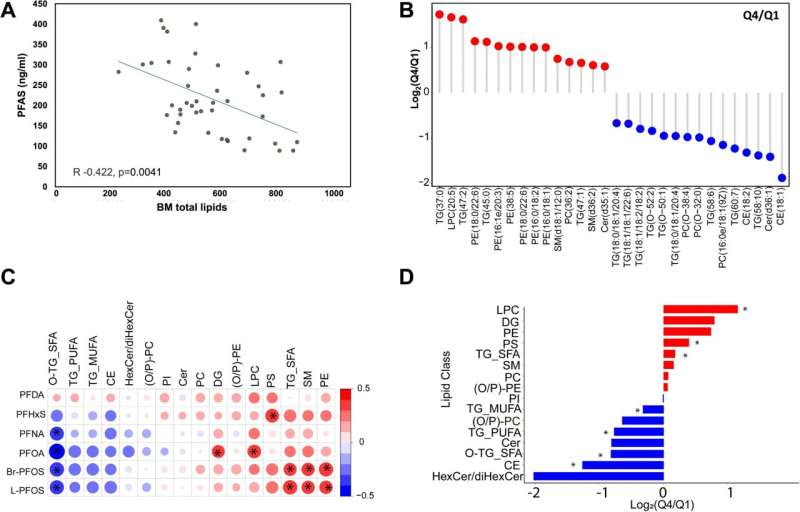Fig. 1. Impact of PFAS exposure on BM lipid levels. (A) Association of total PFAS and total lipids. (B) Significantly-differing lipids for total PFAS quartile 4 (Q4, high exposure) vs. quartile 1 (Q1, low exposure). (C) Correlation plot of PFAS exposure and BM lipid classes. Positive correlations in red, inverse correlations in blue. Dot size for each pairwise correlation corresponds to the strength of the calculated correlation. (D) Overall difference in lipids classes for total PFAS quartile 4 (Q4, high exposure) vs. quartile 1 (Q1, low exposure). *p < 0.05. Here, in section (B) and (D), the log2 fold difference was calculated by dividing the mean concentration of a lipids in one group by another, for instance mean concentration in the the higher exposure level (Q4) by the mean concentration in lower exposure level (Q1) [Fold change lipid class × = log2 mean (Lipid concentration class X in a study group1) / mean (Lipid concentration class X in a study group2)]. Credit: DOI: 10.1016/j.envint.2021.106855
New research shows that exposure to PFAS chemicals is linked with decreasing nutritional value of breast milk. "It's nearly impossible for people to avoid these harmful chemicals. Therefore, we must show what effects they have and get such toxic chemicals banned," says Tuulia Hyötyläinen, professor of chemistry at Örebro University.
The Örebro study is the first to show that the chemicals change the composition of breast milk.
"Several things are going on here. Breast milk is becoming less nutritious because chemical exposure causes changes in lipid composition—the fat in breast milk. There's also less fat in the breastmilk. And we also see the increase in saturated fats at the expense of the healthier unsaturated ones," says Tuulia Hyötyläinen. The study was conducted together with MatejOrešič, professor of medical sciences at Örebro University, and with clinical researchers from the University of Helsinki.
Breast milk affects how a baby grows, including brain development, the immune system, and intestinal bacterial flora.
In the study, researchers analyzed the mothers' blood and breast milk. They asked questions about what the women ate during their pregnancy. In addition, researchers collected stool samples from the children.
"Several previous epidemiological studies have shown that mothers with higher PFAS levels in their blood had a shortened duration of breastfeeding, but this hasn't been explained. On the other hand, animal studies have shown that PFAS affects the mammary glands, potentially making breastfeeding more difficult."
"We believe that the same thing occurs in humans and is perhaps why women who have higher PFAS levels don't breastfeed as long," says Tuulia Hyötyläinen.
PFAS chemicals are transmitted from the mother to the baby during pregnancy and in breast milk. The Örebro researchers could see that the chemicals affected the children's gut—they had a less developed bacterial flora.
"Women are advised to avoid certain foods during pregnancy, but they've already accumulated PFAS substances over many years. In other words, these chemicals are stored in the woman's body," says MatejOrešič.
While it is difficult to avoid taking in these chemicals, the researchers advise avoiding fast food, as some of the harmful chemicals are found in the fast-food packaging.
"The chemicals are also prevalent in fish, shellfish, and meat, as the concentration of toxin increases in the food-chain. They're also found in food packaging in grocery stores as well as in fruit and vegetables," says Tuulia Hyötyläinen.
Even though women cannot avoid these chemicals entirely, they should continue breastfeeding.
"Of course, mothers should continue breastfeeding their babies if they're able to. Breastmilk is the perfect food for newborns, as it's nutritionally adapted to our unique digestive and immune systems. We need to continue our efforts to ensure that these dangerous environmental toxins are banned and phase them out," says Tuulia Hyötyläinen.
Researchers at Örebro University will proceed with an expanded study of 380 women and their children.
PFAS chemicals
Per- and polyfluoroalkyl (PFAS) substances are a large class of synthetic chemicals. PFAS are very difficult to break down and are ingested by animals and absorbed by plants. They have been created to repel grease spots, dirt and water. They are common in frying pans, functional clothing, shoes, furniture fabrics, paper and food packaging, firefighting foam and cosmetics.
They are persistent, and many of them have been shown to have a negative impact on health. The EU has decided to ban some 200 PFAS substances beginning February 2023. The new ban is the result of an initiative from Sweden and Germany. Still, there are several thousand PFAS substances currently in circulation.
More information: Santosh Lamichhane et al, Exposure to per- and polyfluoroalkyl substances associates with an altered lipid composition of breast milk, Environment International (2021). DOI: 10.1016/j.envint.2021.106855
Journal information: Environment International
Provided by Örebro Universitet























